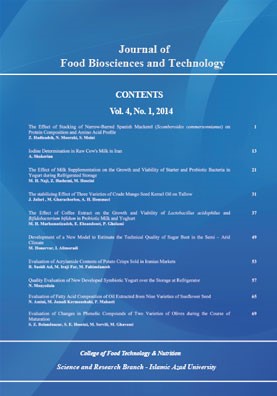Evaluation of Acrylamide Contents of Potato Crisps Sold in Iranian Markets
Subject Areas : food microbiologyR. Saeidi Asl 1 , M. Iraji Far 2 * , M. Fahimdanesh 3
1 - Professor of the Department of Food Science, Sabzevar Branch, Islamic Azad University, Iran.
2 - M. Sc. Student of Food Science, Sabzevar Branch, Islamic Azad University, Iran
3 - Assistant Professor of the Department of Food Science, Shahr-e-Ghods Branch, Islamic Azad University, Iran
Keywords: Acrylamide, Coupled Liquid Chromatography , Iranian Markets, Millard Reaction, Mass Spectrophotometry, Nutritional parameters, Potato Crisps,
Abstract :
: Fried products derived from potato, particularly potato crisp have been widely included in food basket of the households in the recent years in Iran. Potato crisp, among other products, is of great importance and is considered as competitive products. This product is in the list of the food products with high acrylamide content. Therefore, due to the nutritional importance of this product and the fact that previous works have not been carried out regarding the quantity of acrylamide present in the potato crisp sold in Iranian market, the evaluation of the presence of this chemical compound in such product is vital and quite necessary. Seven typical potato crisps sold in the market (salty and in one shape) including five samples of the Iranian potato crisps (T1, T2, T3, T4, T5) and two samples of the foreign potato crisps (T6, T7) were randomly chosen and tested. Quantification of acrylamide was carried out by modern unit of LC-MS-MS. According to the results the highest quantity of acrylamide was found in the sample T1 (1456/67 µg/Kg) and the lowest quantity was in T7 (220 µg/Kg). Statistical analysis also showed that there was a significant difference between the potato crisps produced in Iran and abroad (p=0.0013). The results revealed that the quantity of acrylamide in the potato crisps produced in the foreign countries is less than those in the potato crisps produced in Iran.
Arisseto, A. P., Toledo, M. C., Govaert, Y., Van Loco, J. Fraselle, S., Weverbergh, E. & Degroodt, J. M. (2007). Determination of acrylamide levels in selected foods in Brazil. Food Addit Contam Part A, 24: 236-241.
Boroushaki, M. T., Nikkhah, E., Kazemi, A., Oskooei, M. & Raters, M. (2010). Determination of acrylamide level in popular Iranian brands of potato and corn products. Food Chem Toxicol, 48: 2581-2584.
Budavari, S., O'neil, M. J. & Heckelman, P. E. (1989). The merck index an encyclopedia of chemical, drugs, and biologicals The merck index an encyclopedia of chemical, drugs, and biologicals. Merck, New Jersey, USA, pp. 2564 pages.
Claus, A., Mongili, M., Weisz, G., Schieber, A. & Carle, R. (2008). Impact of formulation and technological factors on the acrylamide content of wheat bread and bread rolls. J Cereal Sci, 47: 546-554.
Farkas, B., Singh, R. & Rumsey, T. (1996). Modeling heat and mass transfer in immersion frying. I, model development. J Food Eng, 29: 211-226.
Iran Standard Method No. 3764 (2011). Characteristics of potato pieces fried in chips oil. Institution of Standard and Industrial Research of Iran, Tehran, Iran.
Low, M. Y., Koutsidis, G., Parker, J. K., Elmore, J. S., Dodson, A. T. & Mottram, D. S. (2006). Effect of citric acid and glycine addition on acrylamide and flavor in a potato model system. J Agr Food Chem, 54: 5976-5983.
Mojska, H., Gieleci, S. I., Szponar, L. & Chajewska, K. (2006). Acrylamide content in potato crisps in Poland. Rocz Panstw Zakl Hig, 57: 243-9.
Tareke, E., Rydberg, P., Karlsson, P., Eriksson, S. & Törnqvist, M. (2002). Analysis of acrylamide, a carcinogen formed in heated foodstuffs. J Agr Food Chem, 50: 4998-5006.
Weiss, G. (2002). Acrylamide in food: Uncharted territory. Science, 297, 27.
WHO. (1994). IARC Monographs on the Evaluation of Carcinogenic Risks to Humans: Schistosomes, Liver Flukes and Helicobacter Pylori, International Agency for Research on Cancer, World Health Organization.
Yaylayan, V. A., Wnorowski, A. & Locas, C. P. (2003). Why asparagine needs carbohydrates to generate acrylamide. J Agr Food Chem, 51: 1753-1757.
Yoshida, M., Ono, H., Chuda, Y., Yada, H., Ohnishi-Kameyama, M., Kobayashi, H., Ohara-Takada, A., Matsuura-Endo, C., Mori, M. & Hayashi, N. (2005). Acrylamide in Japanese processed foods and factors affecting acrylamide level in potato chips and tea. Adv Exp Med Biol, 561: 405-413.
Zhang, Y. & Zhang, G. (2005). Occurrence and analytical methods of acrylamide in heat-treated foods: Review and recent developments. J Chromatogr A, 1075: 1-21.
Zyzak, D. V., Sanders, R. A., Stojanovic, M., Tallmadge, D. H., Eberhart, B. L., Ewald, D. K., Gruber, D. C., Morsch, T. R., Strothers, M. A. & Rizzi, G. P. (2003). Acrylamide formation mechanism in heated foods. J Agr Food Chem, 51: 4782-4787.

